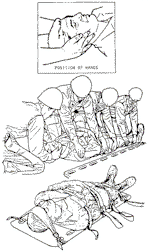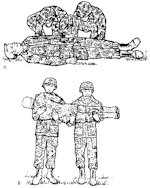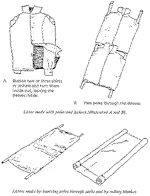|
Medical Education Division |
Operational Medicine 2001
Emergency War Surgery
Second United States Revision of The Emergency War Surgery NATO
Handbook
United States Department of Defense
Emergency War Surgery
Second United States Revision of The Emergency War Surgery NATO Handbook
United States Department of Defense
Home · Military Medicine · Sick Call · Basic Exams · Medical Procedures · Lab and X-ray · The Pharmacy · The Library · Equipment · Patient Transport · Medical Force Protection · Operational Safety · Operational Settings · Special Operations · Humanitarian Missions · Instructions/Orders · Other Agencies · Video Gallery · Phone Consultation · Forms · Web Links · Acknowledgements · Help · Feedback
|
Emergency War Surgery NATO Handbook: Part IV: Regional Wounds and Injuries: Chapter XXXIII: Wounds and Injuries of the Spinal Column and Cord Initial ManagementUnited States Department of Defense Initial management of the individual with suspected injury of the cervical spine entails preservation of the airway, maintenance of ventilation, control of hemorrhage, and the preservation of residual neurological function. Movement of the head and neck must be minimized. When the injured individual presents in the prone position, he should be log-rolled into the supine position with the most experienced person present maintaining the neck in the neutral position. Once the victim is in the supine position, the airway should be maintained with the chin lift maneuver. The neck should never be hyperextended in these situations. If a surgical airway is required, cricothyroidotomy is the method of choice. Stabilization of the neck during transport is provided by a stiff cervical collar or sand bags. Then the head should be taped to whichever extraction device is utilized (Figures 41, 42). When injury to the spine is suspected, spinal alignment must be maintained when the victim is moved. Table 17 summarizes extrication techniques for suspected spine injuries. This can be accomplished by log-rolling onto a stretcher or, where two-man assistance is available, the two-man arm carry is an appropriate method of initial transport to a rigid surface (Figure 43). This technique does not protect the cervical spine; therefore, if cervical spine injury is also suspected, the victim should not be moved until a semirigid collar and spine board are available. In the absence of back boards and stretchers, makeshift litters can be fashioned from doors, lumber, or poles and clothing. (Figure 44).
Approved for public release; Distribution is unlimited. The listing of any non-Federal product in this CD is not an endorsement of the product itself, but simply an acknowledgement of the source. Operational Medicine 2001 Health Care in Military Settings
This web version is provided by The Brookside Associates Medical Education Division. It contains original contents from the official US Navy NAVMED P-5139, but has been reformatted for web access and includes advertising and links that were not present in the original version. This web version has not been approved by the Department of the Navy or the Department of Defense. The presence of any advertising on these pages does not constitute an endorsement of that product or service by either the US Department of Defense or the Brookside Associates. The Brookside Associates is a private organization, not affiliated with the United States Department of Defense. |



